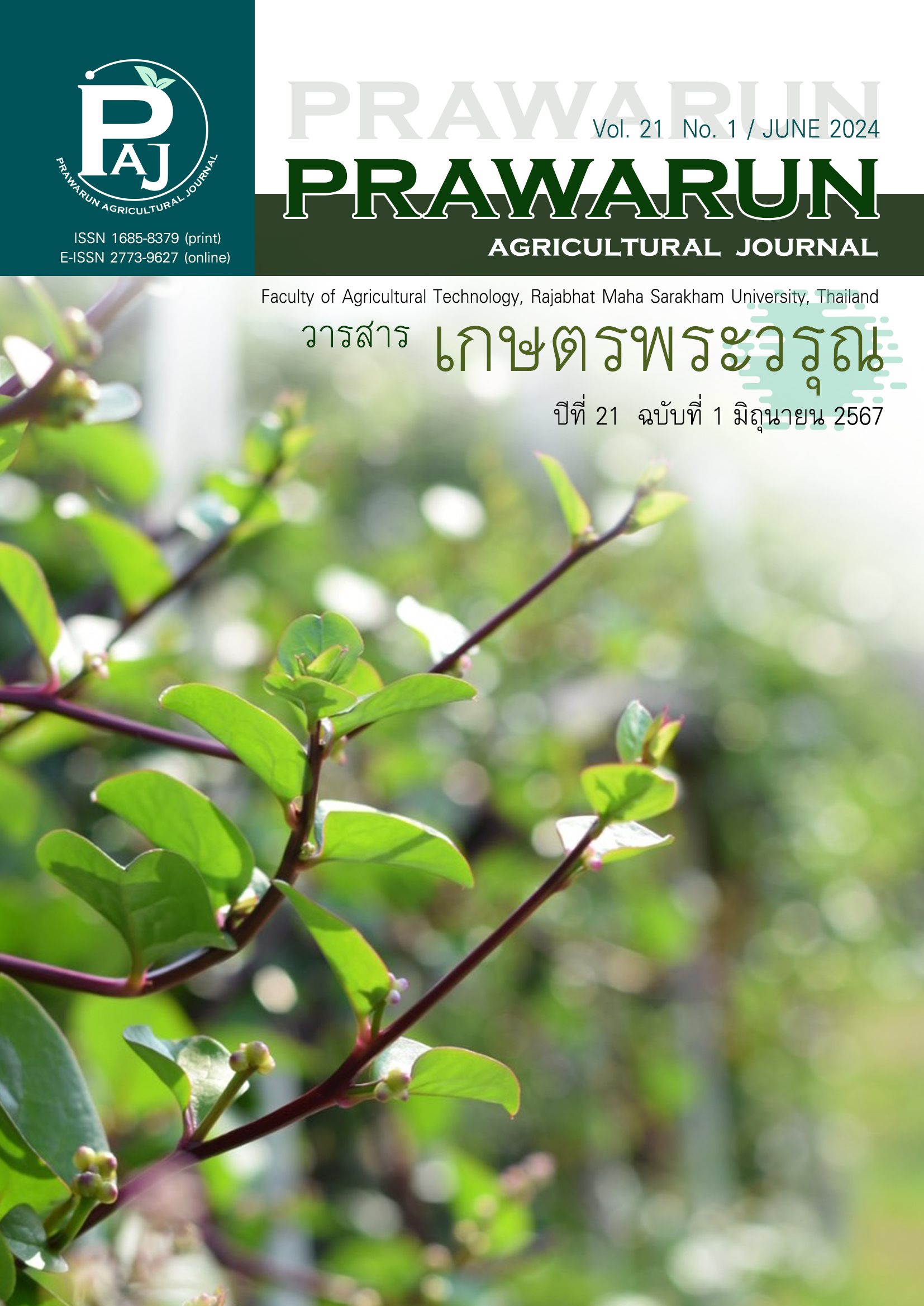ผลของการใช้กากผงชูรสในอาหารต่อสมรรถภาพการเจริญเติบโตของสุกรเล็ก
Main Article Content
บทคัดย่อ
การศึกษาผลการใช้กากผงชูรสในอาหารต่อสมรรถภาพการเจริญเติบโตของสุกรเล็ก โดยใช้ลูกสุกรเพศผู้ จำนวน 12 ตัว ที่มีน้ำหนักเฉลี่ย 11 กิโลกรัม โดยสุกรจะได้รับอาหารข้น แบ่งเป็น 4 กลุ่ม ได้แก่ กลุ่มที่ 1 กลุ่มควบคุม (ไม่เสริมกากผงชูรส) กลุ่มที่ 2 อาหารข้นที่เสริมด้วยกากผงชูรส 1 % กลุ่มที่ 3 อาหารข้นที่เสริมด้วยผงกากชูรส 2 % และกลุ่มที่ 4 อาหารข้นที่เสริมด้วยกากผง ชูรส 3 % ผลการศึกษาพบว่า สุกรทุกกลุ่มมีสมรรถภาพการเจริญเติบโตไม่แตกต่างกันอย่างมีนัยสำคัญทางสถิติ (p > 0.05) แต่ในการเสริมกากผงชูรส 2 % มีอัตราการเจริญเติบโตเฉลี่ยต่อวัน (ADG) ดีที่สุดเมื่อเทียบกับกลุ่มอื่น เช่นเดียวกับผลต่ออัตราการเปลี่ยนอาหารเป็นน้ำหนักตัว (FCR) กลุ่มที่เสริมกากผงชูรส 1 % มีค่าที่ดีที่สุด (p > 0.05) เมื่อเทียบกับกลุ่มอื่น และการคิดคำนวณต้นทุนค่าอาหารต่อการเพิ่มน้ำหนักตัว (FCG) พบว่ากลุ่มที่เสริมกากผงชูรส 1 % มีค่าต้นทุนอาหารต่ำที่สุด เท่ากับ 43.45 บาท ตามด้วยกลุ่มควบคุม กลุ่มที่เสริมกากผงชูรส 2 และ 3 % เท่ากับ 44.75 45.48 และ 47.16 บาท ตามลำดับ โดยสรุปผลการศึกษานี้แสดงให้เห็นว่าอาหารข้นที่เสริมกากผงชูรสมีผลต่อสมรรถภาพการเจริญเติบโต โดยสุกรกลุ่มที่ได้รับอาหารข้นที่เสริมกากผงชูรส 2 % มีสมรรถภาพการเจริญเติบโตที่ดีที่สุดเมื่อเทียบกับกับกลุ่มควบคุมโดยอาจส่งผลต่อระยะเวลาการเลี้ยงที่สั้นลงและการใช้กากผงชูรสในสูตรอาหารสามารถใช้ได้โดยไม่ส่งผลเสียต่อประสิทธิภาพการผลิต
Article Details
References
Al-Badri, G., Leggio, G. M., Musumeci, G., Marzagalli, R., Drago, F., & Castorina, A. (2018). Tackling dipeptidyl peptidase IV in neurological disorders. Neural Regeneration Research, 13(1), 26-34. doi: 10.4103/1673-5374.224365
Burrin, D. G., & Stoll, B. (2009). Metabolic fate and function of dietary glutamate in the gut. American Journal of Clinical Nutrition, 90(3), 850s-856s. doi: 10.3945/ajcn.2009.27462Y
Dai, Z. L., Li, X. L., Xi, P. B., Zhang, J., Wu, G., & Zhu, W. Y. (2012). Metabolism of select amino acids in bacteria from the pig small intestine. Amino Acids, 42(5), 1597-1608. doi: 10.1007/s00726-011-0846-x
Dai, Z. L., Wu, G., & Zhu, W. Y. (2011). Amino acid metabolism in intestinal bacteria: links between gut ecology and host health. Frontiers in Bioscience, 16(5), 1768-1786. doi: 10.2741/3820
Dai, Z. L., Zhang, J., Wu, G., & Zhu, W.Y. (2010). Utilization of amino acids by bacteria from the pig small intestine. Amino Acids, 39(5), 1201–1215. doi: 10.1007/s00726-010-0556-9
Gabriel, A. S., & Uneyama, H. (2013). Amino acid sensing in the gastrointestinal tract. Amino Acids, 45(3), 451–461. doi: 10.1007/s00726-012-1371-2
Gabriel, A., S. Nakamura, E., Uneyama, H., & Torii, K. (2009). Taste, visceral information and exocrine reflexes with glutamate through umami receptors. The Journal of Medical Investigation, 56(Suppl), 209-217. doi: 10.2152/jmi.56.209
Herkelman, K. L., Cromwell, G. L., Stahly, T. S., Pfeiffer, T. W., & Knabe, D. A. (1992). Apparent digestibility of amino acids in raw and heated conventional and low-trypsin-inhibitor soybeans for pigs. Journal of Animal Science, 70(3), 818-826. doi: 10.2527/1992.703818x
Holst, J. J. (2007). The physiology of glucagon-like peptide 1. Physiological Reviews, 87(4), 1409-1439. doi: 10.1152/physrev.00034.2006
Kananurak, P. (1987). Effect of fermented mother liquid (FML) supplementation to growing and finishing swine ration. Agriculture and Natural Resources, 21(3), 263-270. (in Thai)
Kirchgessner, A. L. (2001). Glutamate in the enteric nervous system. Current Opinion in Pharmacology, 1(6), 591-596. doi: 10.1016/S1471-4892(01)00101-1
Lalles, J. P., Bosi, P., Smidt, H., & Stokes, C. R. (2007). Weaning- a challenge to gut physiologists. Livestock Science, 108(1-3), 82-93. doi: 10.1016/j.livsci.2007.01.091
Luise, D., Correa, F., Chalvon-Demersay, T., Galosi, L., Rossi, G., Lambert, W., Bosi, P., & Trevisi, P. (2022). Supplementation of mixed doses of glutamate and glutamine can improve the growth and gut health of piglets during the first 2 weeks post-weaning. Scientific Reports, 12(1), 14533. doi: 10.1038/s41598-022-18330-5
National Research Council (NRC). (1998). Nutrient requirements of swine (10th ed.). Washington, D. C., United States: National Academy Press.
Padunglerk, A., Siwichai, S., Hongyantrachai, S., Prasanpanich, S., & Kongmun, P. (2015). Utilization of monosodium glutamate by-product (TxML) as protein source for lactating dairy cows diet on milk yield, milk qualities and economic value. Proceedings of the 52nd Kasetsart university annual conference (pp. 33-39). Bangkok, Thailand: Kasetsart University. (in Thai)
Reeds, P. J., Burrin, D. G., Stoll, B., Jahoor, F., Wykes, L., Henry, J., & Frazer, M. E. (1997). Enteral glutamate is the preferential source for mucosal glutathione synthesis in fed piglets. American Journal of Physiology-Endocrinology and Metabolism, 273(2), E408-E415. doi: 10.1152/ajpendo.1997.273.2.E408
Rezaei, R., Gabriel, A. S., & Wu, G. (2022). Dietary supplementation with monosodium glutamate enhances milk production by lactating sows and the growth of suckling piglets. Amino Acids, 54(7), 1055-1068. doi: 10.1007/s00726-022-03147-3
Rezaei, R., Knabe, D. A., Tekwe, C. D., Dahanayaka, S., Ficken, M. D., Fielder, S. E., Eide, S. J., Lovering, S. L., & Wu, G. (2013). Dietary supplementation with monosodium glutamate is safe and improves growth performance in post weaning pigs. Amino Acids, 44(3), 911-923. doi: 10.1007/s00726-012-1420-x
Setthithon, S. (2021). Thailand food market report. Accessed June 2, 2027. Retrieved from https://fic.nfi.or.th/upload/market_overview/pdf325.
Smriga, M., & Torii, K. (2000). Release of hypothalamic norepinephrine during MSG intake in rats fed normal and nonprotein diet. Physiology & Behavior, 70(3-4), 413–415. doi: 10.1016/S0031-9384(00)00262-6
Thai Vet Nutri Tech Co., LTD. (n.d.). Analyzed chemical composition and amino acid of monosodium glutamate residue. Chon Buri, Thailand: Thai Vet Nutri Tech Co., LTD.
Umami Information Center. (n.d.). Discoverer of umami Kikunae Ikeda. Accessed April 5, 2024. Retrieved from https://www.umamiinfo.com/ikedakikunae/.
Wang, Z., Zhang, J., Wu, P., Luo, S., Li, J., Wang, Q., Huang, P., Li, Y., Ding, X., Hou, Z., Wu, D., Huang, J., Tu, Q., & Yang, H. (2020). Effects of oral monosodium glutamate administration on serum metabolomics of suckling piglets. Journal of Animal Physiology and Animal Nutrition, 104(1), 269-279. doi. 10.1111/jpn.13212
Wu, G. (2010). Functional amino acids in growth, reproduction, and health. Advances in Nutrition, 1(1), 31-37. doi: 10.3945/an.110.1008
Wu, G. Y., & Morris Jr, S. M. (1998). Arginine metabolism: nitric oxide and beyond. Biochemical Journal, 336(1), 1-17. doi: 10.1042/bj3360001
Yang, D., Li, H., Jia, X., Yu, F., Wang, G., Zhang, Y., Wang, W., Zang, L., & Shi, F. (2023). Carbon footprint of monosodium glutamate production in China. Chemical Engineering Transactions, 103, 739-744. doi. 10.3303/CET23103124

